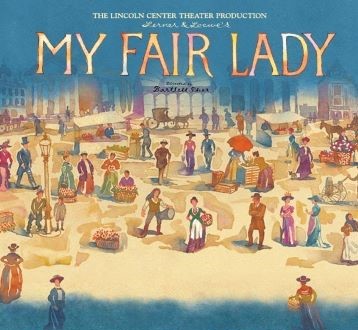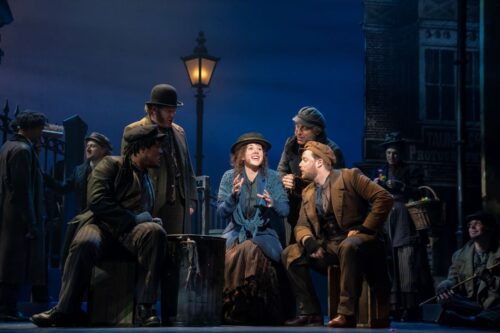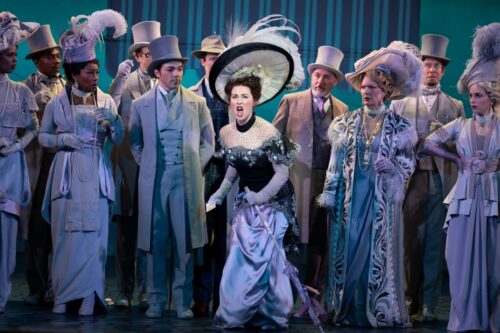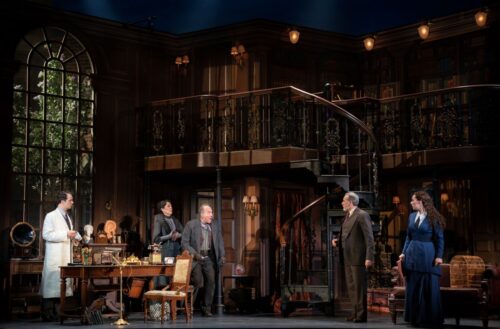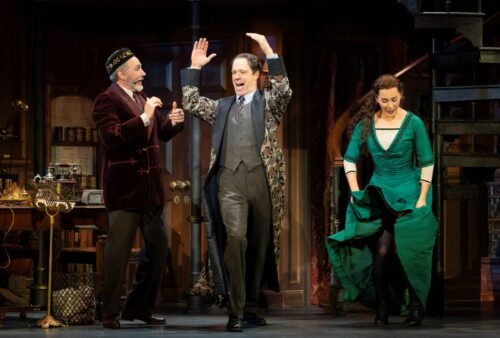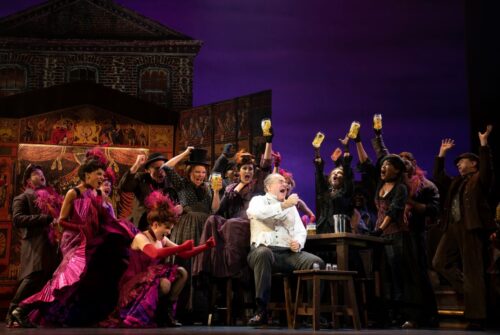MY FAILED LADY
Let’s make one thing clear. When a national touring company of a Broadway success comes to your city, proclaiming it is a duplicate of the original production, what is meant by “production” is that it is guaranteed to have the same sets and costumes and sound design. It will look great and sound great. At least, it should sound great. The big change is in the casting. It is here where a director gets credit for directing the original when, in fact, the director has little to do with what an audience sees when it finally reaches the cities on the tour.
So, let’s take the case of My Fair Lady. Yes, Michel Yeargan’s sets are sumptuous. And it includes a revolving set through Professor Henry Higgins’ house that, while not the freshest idea, works beautifully. And, yes, Catherine Zuber’s costumes are indeed extravagant, maybe a tad too extravagant but always gorgeous to look at. Donald Holder’s lighting design is superbly professional. But, on the other hand, Mark Salzberg’s sound design happens to be seriously compromised by a bad miking system (at least at the Orpheum Theater in San Francisco, the production being reviewed here). So, yes, it looks good. In fact, it looks great. And it still has that gorgeous score by Frederick Loewe and those still-extraordinary lyrics by Alan Jay Lerner.
Then there is the matter of the director and the anticipation that comes with knowing the show has been helmed by Bartlett Sher, whose body of work includes memorable productions of Light in the Piazza, Awake and Sing, To Kill A Mockingbird and the absolutely stunning revivals of South Pacific and The King and I, which were faithful to the originals while breathing fresh new life into both.
Indeed, I was telling my companion that when the audience saw a full orchestra emerge at South Pacific and heard that familiar overture, the audience was welled up with tears even before the curtain went up. Which comes to the difference between the Lincoln Center audience and the audience at the Orpheum at last week’s opening performance of My Fair Lady. The audience continued chatting through the overture and through its opening images, hardly the best way to approach a masterpiece.
Back to Mr. Sher. He hand-picked his cast, choosing performers who could act as well as sing, who have chemistry between them, who could transmute Sher’s directorial concepts into the kind of magic that ultimately separates a brilliant production from a perfunctory one. So, while watching this performance, one couldn’t help but imagine what that performance was like.
One of Sher’s excellent ideas was to revert to the original ending of Pygmalion in which Eliza Doolittle, the play’s heroine, walks out on Henry Higgins, as George Bernard Shaw originally intended. Indeed, the sentimentality of the ending we all think we know as the real ending was introduced in the film version of Pygmalion. At the Lincoln Center, when Eliza walks off, it must have been deliberately and majestically handled, because she had to actually leave the stage and leave the theater in full view of the audience. Here, Eliza casually walks off stage towards the wings, making us wonder why she even bothered to come back to Higgins in the first place. So this is both Sher’s adaptation of My Fair Lady‘s original and now familiar finale and Shaw’s original ending, handled a bit too cavalierly in the touring version. The reason it needs to be strong is that we are living in a time when we have finally come about to Shaw’s feelings about the rights of women.
But even Sher has to be called on for what he has done, with the help of Christopher Gatelli’s choreography, to “Get Me to the Church on Time.” Can-can dancers in a London pub? Four of them men in drag, there to hoist Alfred Doolittle aloft at the finale? Bad choices, and Sher is as responsible for them as he is for all that’s good in the show. This might be an audience pleaser but it strikes a discordant note.
As for the cast, this is where the trouble begins and ends. They seem to have been chosen for their vocal abilities rather than for their acting or, more important, for their rightness as the characters they are playing. Alfred Doolittle, one of the funniest and wisest characters in all of dramatic literature, has been reduced to a bumbling lout. Mrs. Higgins, the elegant dowager, looks as if she is preparing for a vaudeville turn. Henry Higgins is so mean-spirited and charmless that the new ending could be predicted in the first ten minutes. Freddy Eynsford-Hill has an extraordinary tenor voice, perhaps marred by too much vibrato, but doesn’t seem to be separated from Eliza by class and why Eliza chooses him, even given her desire for respectability and her own flower shop, is puzzling. Just because he sings “On the Street Where You Live?” Eliza and Freddy never seem to connect.
For one viewer, the only cast members who come across with almost full success are Shereen Ahmed as Eliza and Kevin Pariseau as Colonel Pickering. They have characters to play and they play them. Ms. Ahmed is particularly good, especially when giving full-throated voice to her songs, and particularly in her spectacular performance of “I Could Have Danced All Night.” But, in the fool-proof comic scene when Eliza wonders aloud, in her perfectly learned English, how her aunt died of influenza, the playing gets so broad and over the top that one cringes more than one laughs. In a moment like that, we do not need to be hit over the head.
And I’m afraid that the part of Higgins belongs forever to Rex Harrison — who seemed to crackle with pleasure at the chance to speak/sing those brilliant Lerner lyrics, so many inspired by Shaw’s own words — just as the part of Stanley Kowalski belongs forever to Marlon Brando. Therein lies the power of the original cast. I know. We can’t expect that kind of greatness every time we go to the theater. But My Fair Lady deserves better.
photos by Carol Marcus
My Fair Lady
National Tour
reviewed in San Francisco at The Orpheum November 2-28, 2021
also plays in Costa Mesa at Segerstrom Center January 11 – 23, 2022
for tickets, cities, and more dates, visit My Fair Lady
